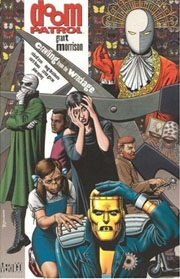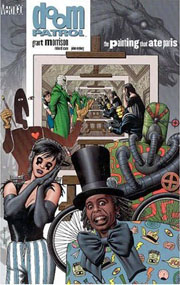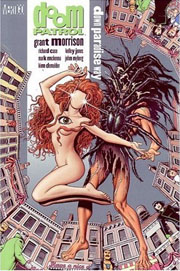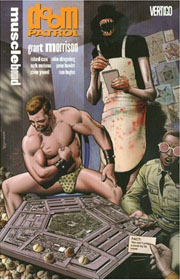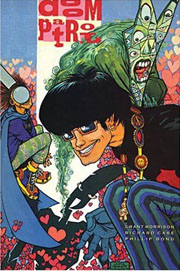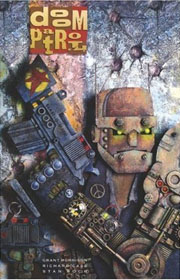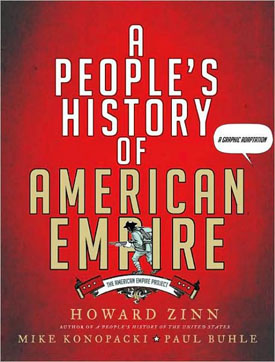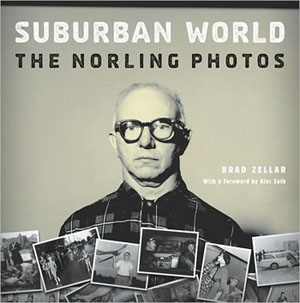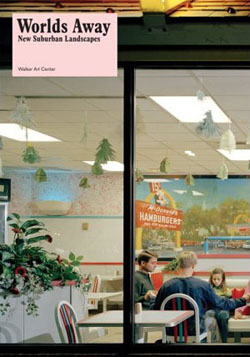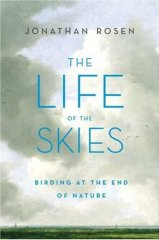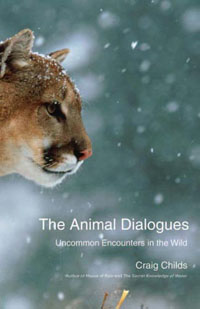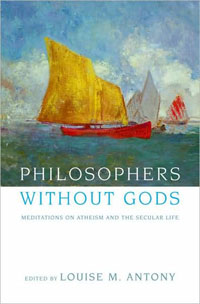
by Eric Lorberer
One expects, perhaps, to engage in a bit of schadenfreude when it comes to the fiction of Chip Kidd. After all, he’s already famous for his innovative, almost idiosyncratic approach to the book jackets he has designed—primarily for the esteemed publishing house of Alfred A. Knopf, where he has worked his way up from junior assistant to associate art director, but also for many other lucky publishers—since the mid-80s. The accolades Kidd still regularly receives for his design work are well-deserved, as can be seen in the Chip Kidd: Book One, Work: 1986–2006 (Rizzoli, 2005), a lavish yet surprisingly information-packed exploration and celebration of his unique visual sensibility. And his skills have been put to particular good use in the last decade, when rising interest in graphic novels has given Kidd, a lifelong comics fan, a chance to package a fascinating range of work in this medium to a bookish audience.
So given Kidd’s undeniable talent and justifiable acclaim for his work on the art side of the book world, it just didn’t seem fair when The Cheese Monkeys (Scribner, 2001) turned out to be a terrifically engaging, whip-smart novel that packs a treatise on design inside a coming-of-age tale set in the ’50s (significantly, a generation before Kidd’s own: he was born in 1964). And it seems even less fair that his new novel The Learners (Scribner, $26)—insouciantly subtitled “The Book After The Cheese Monkeys,” and, indeed, a sequel that in retrospect deepens the thematic heft of its forerunner—is even better. Part of its strength is that it follows the protagonist Happy as he grapples with the darkness at the heart of the dawn of the ’60s, figured here in what Kidd convinces is the most insidious design achievement imaginable: the Milgram experiments. Not fair, no; but then again, the fact that Chip Kidd has more than one superpower turns out to be a boon for readers. And isn’t that what matters most?
Eric Lorberer: It was a welcome surprise to return to the world of The Cheese Monkeys. Did you have these two novels planned from the beginning?
Chip Kidd: Yes. I very much did. I initially sent the proposal of what I wanted to do to my agent a long time ago. It was at first a massive sprawling thing that took place in three sections: high school, college, and then work, culminating in the Milgram experiments. But my agent said, this isn’t one book, it’s three—and the college stuff is the strongest and most interesting. Why don’t you make a book out of that and then proceed if you want to.
EL: So will there be a novel about high school?
CK: I don’t know. The whole concept of high school... I don’t see what unique spin I could possibly put on it that hasn’t been done to death at this point. And it would have to have some sort of design angle to it, but I wasn’t even conscious of graphic design until college, and that’s what The Cheese Monkeys is about. I don’t know—it’s on permanent hold at this point.
EL: The novels really work as a diptych anyway: one is focused on form and the other on content. So rather than just a sequel, The Learners is more like an expansion of the theme...
CK: I love that you’re saying that, really. I thought of it as a sequel that’s not supposed to act like a sequel.
EL: Despite the fact that the novels are set before you were born, I’m tempted to ask how much the characters and story are based on your own experiences. The character of Himillsy, especially, is so complicated.
CK: Himillsy is a fusion of two girls that I knew in college; I only seem to keep in touch with them every couple of years, about which I feel horribly guilty. But yeah, she’s pretty complicated.
EL: On one hand she is a burst of energy, and a revelation to Happy… and on the other hand, she is somewhat toxic.
CK: Himillsy is a classic case of wasted potential. Happy is enthralled with her ideas, some of which are flat-out brilliant, and some of which are totally off the wall, and yet really worth considering—things he had not thought about before. But what’s implied is that she doesn’t do anything with them. It’s one thing to come up with ideas all day, however brilliant they are, and that leads back to the epigram of the book: “An idea ahead of its time is not a good idea.” I don’t know if you knew people like this at school, but as a freshman, I would see so many seniors doing amazing work, and you think, they’re just going to light the world on fire. And then you never hear of them again. Or worse, you keep in touch and they end up in the art department of some parochial newspaper, and next thing they know they’re married with two kids, saying I can’t quit this job, I’d be crazy! And that’s kind of who Himillsy is, except she doesn’t even have a job at the newspaper. She’s in this awful place where she knows what greatness is, and she thinks she can probably attain it, but she’s ultimately too scared to take the risk.
EL: I’m guessing you set the books in a previous era to avoid those direct parallels to your own coming of age.
CK: You know, I kept being asked about that when The Cheese Monkeys came out, and the answer is very simple: the Milgram experiments. While these are very much novels, every aspect of the Milgram experiments is historically accurate. Early on even my editor asked, does it have to be the actual Milgram experiments? Can’t you paraphrase it or change it? And I said, No, no, no—all of that has to be completely authentic. So once that was established, The Cheese Monkeys has to take place in 1956. But it wasn’t a bad fit: It’s a little bit more of an innocent time, which suits the story. And it’s before any kind of political correctness, so in The Cheese Monkeys, Winter can be as thuggish and abusive as he wants, and he doesn’t have to be worry about students complaining or ratting him out. It’s also a curious time in American history, a post-war, pre-ironic era. Everything is about to change, completely change. And aspects of graphic design are what help that to happen.

EL: Perhaps especially the aspects exploited by advertising...
CK: That’s right—actually, 1961 is the precise year when the “new advertising” started, so you had Volkswagen ads that said “Lemon” with a picture of a Volkswagen, for example. That’s when all that started to happen. The Learners is set it in that milieu, but it isn’t about advertising. So everything is about to change. Happy comes up with a concept which today would be totally embraced, but back then was kind of laughed at.
EL: What do you think of the direction advertising has taken?
CK: I think that absolutely anything goes. And with YouTube we’re now seeing ads for mainstream products that they can’t show on TV. A lot of them are from Europe; a lot of them are from Japan. There are two of these British ads for a car in which—I forget what car it is, a subcompact car with everything automatic—and this bird lands on the hood of the car, what do they call it—
EL: The bonnet?
CK: Right, and the car automatically opens the hood and smashes the bird against the windshield, killing it instantly, and then pulls it back down. Which is sort of an illustration of how sophisticated this car is. And it’s perfectly executed, totally hilarious. If you did it in a Wyle E. Coyote cartoon, you wouldn’t have a problem, but there it is—on film. Another in that series has a cat that’s curious that sticks its head in an open window that just falls and just guillotines its head right off. Again, it’s perfectly, brilliantly done. But they would have a problem showing that on American TV.
EL: I notice the names of your characters are homages to friends and colleagues, but also just in general, they’re really out there.
CK: It’s one of my indulgences as a writer, these crazy names—they’re either names of friends, as you pointed out, or just part of the fun for me. I know in a way it’s kind of shameless, but so much of writing the books is painful for a variety of reasons, so damn it, I’m going to have fun with the names. And if people don’t like it, then they don’t like it. There are a few that I actually reeled in and toned down.
EL: Well, not Dick Stankey.
CK: Not Dick Stankey. There is a real Dick Stankey. As a writer, and I’m sure most writer’s do this, especially if you’re working on a book for a long amount of time, you’ll collect things like a magpie, and names are definitely one of them. I’ll come across something in a newspaper, or... actually, this somebody told me about—a friend’s father was named Dick Stankey, and they had to fight not to crack up every time they were in his presence.
EL: That reminds me, back when I worked in retail, I once took a credit from a Richard Schmuck, and it was the end of a long day... I mean, “Dick Schmuck”? I had a really hard time holding back my nervous laughter.
CK: Now why wouldn’t he change that? Are you sure he wasn’t a performance artist or something?
EL: I don’t think so... the name seemed apt.
CK: Wow.
EL: So besides ads and innovative graphic design, it seems what motivates your writing is comics.
CK: Well, there’s definitely a comic strip element to The Learners. With Spear, the head art director, a lot of personality traits were based on Chris Ware—but it’s Chris as tragic figure. What if he had that kind of talent but in another era? For whatever reason, whether it was for practical reasons or what have you, he might not have the courage to follow through and become a cartoonist. He would take the safe route and join an ad agency and design ads with it—beautiful ones, I really try to build the case that these things are works of art—but they’re not selling the potato chips anymore, so they’re actually sort of a failure. I love that concept. It’s devastatingly sad.
EL: In a lot of artistic disciplines, that kind of failure can become a strength—like in poetry, where the audience is small but passionate. Do you know this Martin Amis story—
CK: Where the rock star and the poet switch?
EL: Yes!
CK: It’s so funny, and he pulls it off too.
EL: So what is it when our successes are our failures?
CK: You have to define what success or failure means. In this book, these ads technically are failures because this guy comes in and says our potato chips sales have been steadily declining for the last five years now. These cartoon ads aren’t helping. We need to find something else. He can quantify that they are failures. Luckily we can’t do that with book covers.
EL: So the failure to communicate, to make something happen… I think the assignments Winter gives the class also explore that dynamic. What is actually going to happen as a result of graphic design? This takes us to the topic of design, I guess. I notice you design your own book covers... is that different than doing covers for other authors?
CK: It’s totally anxiety-producing, until I come up with something that I think will work. In both the novels, Chris Ware has played a tremendous part. For the first book I told him I need you to draw a piece of cheese and some monkeys and do the lettering and blah, blah, blah, and in The Learners, I wanted some really great, hand-done commercial cursive script... and of course he completely came through each time. It’s kind of absurd—it’s kind of like asking Frank Lloyd Wright to design your outhouse.
EL: It sounds like it’s probably not different from the process of designing someone else’s book…
CK: There’s a lot more pressure that I put on myself, but the goal is the same: I want it to look really good and work in the bookstore.
EL: I like how in Chip Kidd: Book One you said that as a kid you wanted to be like Roger Dean. His album designs really did capture the music...
CK: I know! And that crazy Yes logo—where is that S going?
EL: It’s genius.
CK: It is genius, but it’s evil genius.
EL: I wanted to come back to content and form. You have these almost didactic passages in The Learners—were you trying to tap into the novel as criticism?

CK: It’s not really novel as criticism, but it goes back to what I learned in school. The concept that is hiding in plain sight, you have to consider if you want to be a designer. What does it mean to be big? What does it mean to be small? It sounds like something out of the second grade—and yet, you see things that aren’t prioritized all the time. That’s how it translates to me. What does it mean to go from top to bottom? What does it mean to go from left to right? Very basic stuff. It was a bit easier in The Cheese Monkeys, but it was a lot trickier to talk about content that way inThe Learners. Already some reviews have said that’s the weakest part of the book. I guess it is what it is. But I wanted to explore the idea that content itself could be divided into its own sort of form and content: what somebody says as opposed to what they mean. If they’re not the same thing, then what is it?
EL: I think it’s really successful. And as big a fan as I am of The Cheese Monkeys, I think The Learnersis even better because it grapples with more difficult subject matter.
CK: Good! That’s what I was trying to do.
EL: Somehow your pastiche of this form/content dichotomy reminded me of the Alan Alda character inCrimes and Misdemeanors, when he says—
CK: “If it bends it’s funny, if it breaks it isn’t”!
EL: Exactly! And Happy’s experience, being on that line between bent and broken, I guess that’s a way at getting at the Milgram experiments. What made you fascinated with them, and how do you think they relate to your characters?
CK: What fascinated me about them in large part was that they represent a truly monumental achievement in 20th-century design—and more specifically, mid-20th-century, post-war, American design. Basically, Milgram said we’re going to recreate in a lab why the Holocaust happened. And he did. He did, but purely through deception. It was a ruse. It was a trick. Those people were duped into revealing who they really were. And Happy is among them, and it fucks him up. As much as he is in awe of the achievement of these experiments, he’s undone by them. I’m not trying to make a moral judgment about them, so much as an observation of what all the implications are, and to show that this is what design is too. It’s not just making a cover on a magazine, or a poster, or a logo. It’s purposeful planning. The Milgram experiments were the most clever, diabolical pieces of purposeful planning that I had ever encountered.
EL: Your partner, J.D. McClatchy, is a poet. Does that affect your sensibility as either a novelist or a designer?
CK: That’s interesting! I’d never heard it asked quite that way. But I’d say yes, definitely.
EL: How is it normally asked?
CK: It’s normally asked, So your partner was a finalist for the Pulitzer Prize and editor at the Yale Review—what does he think about what you do?
EL: Hmm... I guess I don’t care about that.
CK: Sandy reads everything I write and comments on it, and I think it affects me a great deal. Now, we have different sensibilities: I tend to go for the cheap joke, the pie-in-the-face pratfall, the outrageous, while he is more high-minded than that. But he also has a much more lilting, old-world take on how to express something and articulate it. And some of that I sort of take to heart. Plus, there’s the whole Yale connection with this book; I was constantly asking him about factual stuff.
EL: Have you ever had to design a book that you really didn’t like?
CK: If you have been doing this as long as I have, of course I have. Now, would I design a cover for Ann Coulter or Bill O’Reilly? Absolutely not! It’s one thing to design a cover for a novel that’s notUlysses, it’s another to design a cover for a book that basically teaches people to think like an asshole. I feel very privileged at Knopf that we would not publish something like that.
EL: It’s not a place where you’re told, Hey it’s your job.
CK: Exactly. I really feel sorry for people who have to do that shit because they don’t have a choice. It’s very easy to get on your soapbox, but if you have a family to support, and you have to design O.J.’s If I Did It book—it’s sad, really sad. Every now and then I’ll be asked to do something that even just from the description of what it is on the phone, I’ll know that life is not long enough to be involved. I’m really lucky that way. I don’t have to make a lot of those decisions.
EL: You mentioned, again in Chip Kidd: Book One, that you came to read Thomas Bernhard when you had to design his books. Are there any other authors you have discovered in that way?
CK: Oh yeah, a lot! James Merrill—which ended up becoming a huge part of my life because Sandy is his executor and was his great protégé. I would never have tried to read that stuff on my own, it’s so over my head, but when Sandy explains it to me, I understand it. It’s like taking a class in the best way. I’ll never get it on my own, but if someone who understands it can tell me what it’s doing and how it works, then I can get it. Most poetry is over my head—if it’s really good. Wallace Stevens, Elizabeth Bishop, Robert Lowell, even Auden, I need a lot of it explained to me. But then when it is, I can appreciate it. But I find it very, very difficult to understand and appreciate it.
EL: That’s the beauty of it.
CK: Yes, it is.
EL: You’ve designed so many amazing book covers, is there anything you wish you could design?
CK: I would love to do Nabokov’s oeuvre... I did five of his titles for a Brazillian publisher in paperback, but I’d love to do all of his work. I have a special love for Lorrie Moore, Alice Munro... I’ve been so lucky. Did I mention the Batman in Japan project? That’s my next big mainstream comics project, basically unearthing and translating over 300 pages of vintage Batman comics that appeared in Japan in 1966, especially for the Japanese market. Totally licensed by DC Comics, not bootlegged.
EL: They’re Manga style?
CK: [Nods yes] Amazing. Really, really cool.
EL: Did you find these comics in Japan?
CK: Well, interestingly my trip to Japan to find them was totally fruitless, so I’ve been working with a collector who is equally as passionate as I am. I found some, and he’s found a lot. We’re basically just photographing old comics, because that’s what there is. I think you’re going to dig it.
EL: That’s what I love about comics—there’s so much subtext. How a culture appropriates and reacts to an icon like Batman is fascinating.
CK: It’s one of the coolest cross-cultural things you’ll ever see. In a strange way it’s very true to Batman and Robin—Robin is twelve years old and looks like a kid—but now they’re fighting a dinosaur that’s risen out of the city. And there are some very Japanese-centric concepts about them. And also it looks great! A lot of the stories are about how mankind mistreats the animal kingdom. There’s also a story about how this one guy is evolving into the next mutant race, and... it’s complicated, but basically it looks at how if you don’t clean up your act, it will destroy you.
EL: I’m glad to hear about this. At Rain Taxi, we’ve always tried to downplay the divide between mainstream comics and indie comics... it’s all the same medium, and there’s going to be interesting things on any side of that artificial line.
CK: I get mad at my indie friends who would never read Astonishing X-Men—it’s so fucking good! Or Grant Morrison’s Superman comic, it’s wonderful. When mainstream stuff gets done well, it’s for me as good as when indie stuff is done well. And there’s a lot of shitty indie stuff. Hello! Just because it’s about squatting in the East Village doesn’t make it interesting.
Check out The Learners video on YouTube!
Click here to purchase The Cheese Monkeys at your local independent bookstore

Click here to purchase The Learners at your local independent bookstore

Click here to purchase Chip Kid: Work 1986-2006 at your local independent bookstore

Click here to purchase Bat-Manga!: The Secret History of Batman in Japan at your local independent bookstore

Rain Taxi Online Edition, Spring 2008 | © Rain Taxi, Inc. 2008
 Dan Machlin
Dan Machlin








